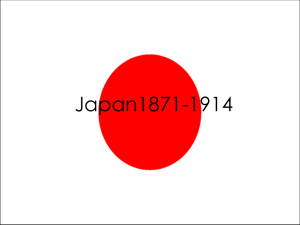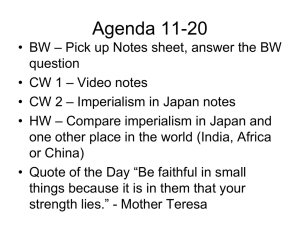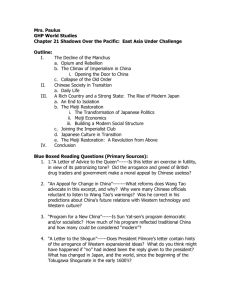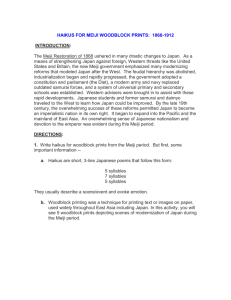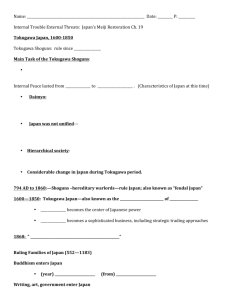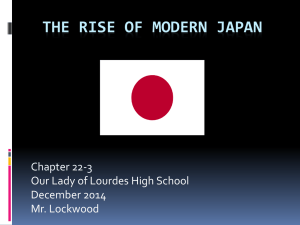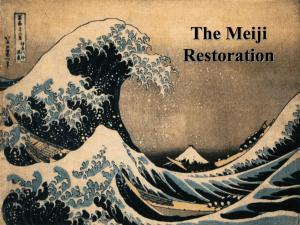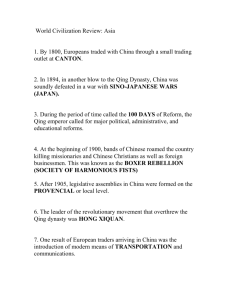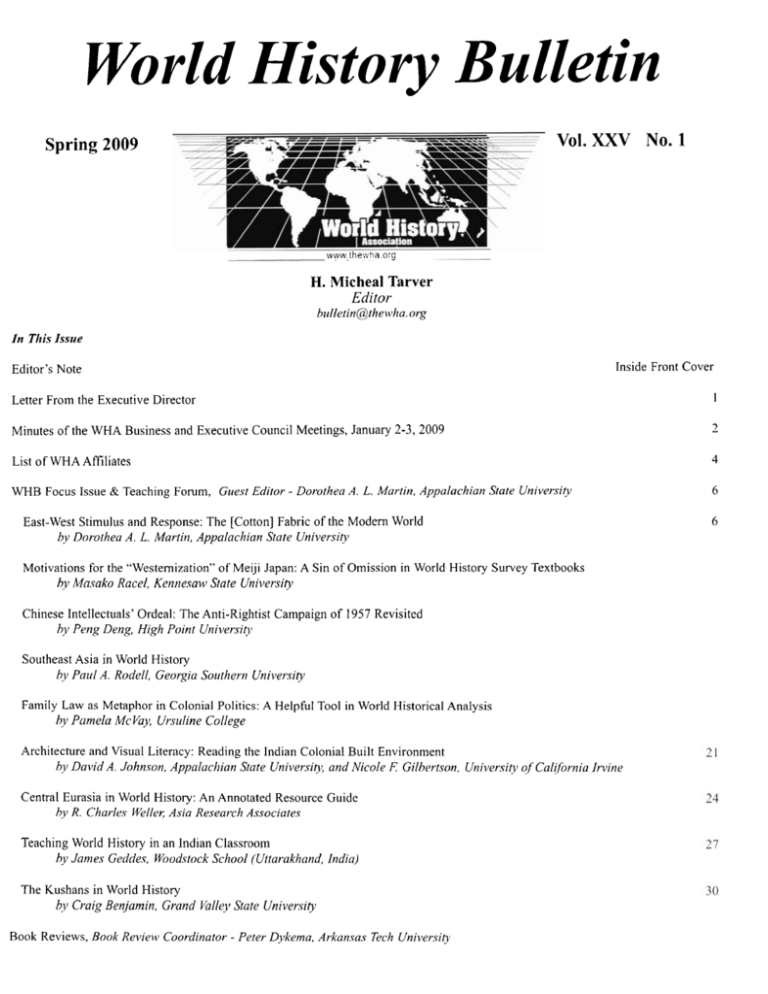
World History Bulletin
Vol. XXV No. 1
Spring 2009
ivywJhe':iha
org
H. Micheal Tarver
Editor
blrlletin@thelvha.org
In This Issire
Editor's Note
Inside Front Cover
Letter From the Executive Director
1
Minutes of the WHA Business and Executive Council Meetings, January 2-3, 2009
2
List of WHA Aff~liates
4
WHB Focus Issue & Teaching Forum, Guest Editor - Dorothea A. L. Martin, Appalachian State University
6
East-West Stimulus and Response: The [Cotton] Fabric of the Modern World
by Dorothea A. L. Martin, Appalachian State University
Motivations for the "Westernization" of Meiji Japan: A Sin of Omission in World History Survey Textbooks
by Masah-o Racel, Kenr~esawState University
Chinese Intellectuals' Ordeal: The Anti-Rightist Campaign of 1957 Revisited
by Peng Deng, High Point University
Southeast Asia in World History
by Paul A. Rodell, Georgia Southern University
Family Law as Metaphor in Colonial Politics: A Helpful Tool in World Historical Analysis
by Pamelrt Mc Vay, Urslrline College
Architecture and Visual Literacy: Reading the Indian Colonial Built Environment
by David A. Johnson, Appalachian State University, and Nicole F: Gilbertson, University ef California Iwine
Central Eurasia in World History: An Annotated Resource Guide
by R. Charles Weller,Asia Research Associates
Teaching World History in an Indian Classroom
by James Gerlde.~,Woodstock School (Uttarakhand, India)
The Kushans in World History
b,v Craig Benjamin, Grand Vallel~State University
Book Reviews, Book Review Coordinator - Peter Dykema, Arkansas Tech Universip
6
years from 1979 to the present is the subject of
much debate. For purposes of this paper, however, suffice it to say that the recent steady doubledigit growth of China's manufacturing sectors
may have again reached the levels where they can
command the resources, both materials and labor,
to be acknowledged as the global workshop.
Cotton textiles once more play a significant role
in this process. As those of us in the American
South are very aware, the demand for cheap cotton textiles has been quickly responded to first by
China and to a lesser extent India. Cheaper labor,
fewer safety regulations, government support,
and even cheaper energy cost have made factories
in Asia today the largest producers and consumers of cotton staple and textiles. Wal-Mart
alone weighs in as China's largest single buyer,
out pacing several other nations or regions of the
world. In 2008, "China, India, Pakistan, Turkey
the USA and Brazil lead the world in both the
~
production and consumption of ~ o t t o n . "The
USA, as did India in the 19" century, now exports
more cotton staple than is used in its domestic
production, a clear reflection of the reality of the
transfer of textile production.
In spite of a slowing global economy, India
is projected to increase both its output and consumption of cotton over the next year while
China will remain the largest consumer of this
resource at 51 million bales [of the 86.2 million
bales consumed by Asia's four main textile producers]. Faced with an economic downturn and
fewer exports, China has begun refocusing attention on expanding its domestic market growth
and infrastructure developments.
Many have raised the issues of the sustainability of this level of growth, speculating that
there will not be enough resources to go around especially energy resources - to reproduce the
industrial revolution in Asia with its large population. But, this might be the opportunity for Asia's
new leaders to respond with innovation in the
area of renewable and "green" energy technology.
Others point out that "historically, rapid internal
economic growth has propelled states to redefine
and expand ...more robust military capabilities to
pursue and defend" their global interest.8
It is this similarity to other historical periods
that is at the root of the China bashing - have not
other global economic powers also secured their
place through force of both money and arms?
But nationalism in the world of the 2 1st century is
not the same as that of the earlier periods and
China's and India's internal circumstances are
unique to their own historical realities. Writing in
the N a v York Emes Jan. 1, 2009, Gurcharan Das
pointed out that "[Bloth the Chinese and the
Indians are convinced that their prosperity will
only increase in the 2ISt century. In China it will
be induced by the state; in India's case, it may
well happen despite the state. Indians expect to
continue their relentless march toward a modem,
democratic, market-based future.. .. Indians are
painfully aware that they must reform their government bureaucracy, police and judiciary -
institutions, paradoxically, they were so proud of
a generation ago. When that happens, India may
become formidable, a thought that undoubtedly
womes China's leader^."^
As both these countries move to more
sophisticated high tech and service industries,
however, modem production of cotton textiles is
moving to other parts of Asia with more products
either being produced or assembled in Vietnam,
Cambodia, etc. Can this again be the leading
industry to create modernity with rising per capita incomes, greater urbanization, and a more
highly skilled work force? Will economic control
in the 215' century, once again in the hands of
Asian actors, help spread textile activity to these
areas to exploit lower labor cost and safety standards and evade environmental regulation? One
can hope that new international institutions such
as the WTO and reevaluation of the post World
War I1 Bretton Woods system of international
oversight of global monetary funds could exert
some control or guidance over the process using
diplomacy rather than force of arms used in the
1 9 and
~ 20th centuries by the West to secure its
economic dominance.
Motivations for the
"Westernization" of Meiji Japan:
A Sin of Omission in World
History Survey Textbooks
Masako N . Racel
Kennesaw State University
In the periodization of Japanese history, Japanese
and Western historians alike generally identify
the Meiji era (1868-1912) as the beginning of
modem or "Westernized" Japan; while its immediate predecessor, the Tokugawa era (1603-1 868),
is typically depicted as a feudal age. This perception is reinforced by the treatment of Japanese
history found in most college-survey world history textbooks.1 According to these texts,
Tokugawa era Japan was populated by a Shogun,
Daimyo, and samurai wearing kimonos, sporting
topknots, and carrying swords. In stark contrast,
Meiji era Japan is represented by images of modernization punctuated with the Japanese adoption
of Western dress, architecture, and technology.
Modem Japan is often presented as a success
story whereby it fended off Western imperialism
ENDNOTES
by modernizing and "Westernizing" itself to
become "the only non-Western nation to successWilliam H. McNeill, "The Rise of the West After 25
fully industrialize and achieve a Western standard
Years. "Journal ofll'orld Hisroq, Vol. I, No. 1, 9-10.
of living before World War
Phillip Adler in
See The English Wool Marker ~1230-1327by Adrian R.
World
Civilizafions
(5th
edition)
states:
his
Bell, Chris Brooks and Paul R. Dryburgh, (Cambridge:
Cambridge University Press). 2007.
Japan seems on the brink of being
Roben Tignor, et al., Worlds Together Worlds Apart, 2nd
reduced to yet another helpless victim
edition, Vol. Two, 577.
of Western imperialism, but at this
Cf., "Rethinking Wages and Competitiveness in the lgth
point, a decisive difference emerged.
century: Bntain and South India." by P. Panhasarathi, in
Some of the daimyo and samurai faced
Present & Pasr, 158 (Feb.1998), 79-80.
the causes and consequences of
Roben Tignor, et al., Worlds Together Worlds Aporr. 2nd
Japanese impotence squarely: they
edttion. Vol. Two. 673.
decided to imitate the West as rapidly
Mark Elvin. 7'he Panern qfrhe Chinese Pasr, (Stanford.
Stanford University Press), 1973, 3 13-3 14.
as possible. . . .
Jim Borneman, "Conon Data Provide Insight into
. . . one major reform after another
Continuing Trends in a Changing Global Textile Marketplace,"
came
out of the imperial capital in
Terrile World -Cotton Numbers Revisrred, http://u?w.textile
world.comlArticles/2008~ecember~2008IFeature~lCohon~Nu Tokyo (formerly Edo). All were modmben-Re.. . accessed 1/6/2009.
eled on the West. . . . [Tlhey systemM. Taylor Fravel, "Rising Power, Terntory and War," io
atically carried out reforms, even at the
Precis, MIT Center for Internahonal Studies, Fall 2008, 2.
expense of cherished tradition.3
Gurcharan Das, "The Next World Order," accessed
1/3/2009 at http:llwww.nytimes.com~2009/01/02/opinion/
02das.hhnl?_r=l &th&ernc=th
Make Plans Now!
19thAnnual Conference
June 24-27, 2010
San Diego, California
By definition, survey textbooks must condense complex historical processes into simple
and accessible forms, but such simplifications
may lead students to think that Japan's rise as a
world power was accomplished by "imitating"
"superior" Western civilization and abandoning
the traditional way of life. What most textbooks
fail to address are 1) the Meiji government's
reliance on traditional elements to pursue its
Westernization policies, and 2) the motives
behind adopting Western institutions and technologies. By understanding these two items, one
can approach Meiji Japan as more than a case of
Western "imitati~n."~Indeed, teachers can use
the story of Meiji Japan to explore the meanings
of "Westernization" and illustrate an important
historical process whereby foreign and tradition-
-
earth."ccording
to Shinto
mythology. the Emperor
-~
A=--=.
4
F - ~
descended from the sun
goddess, Amaterasu, and
therefore, his role included
being the chief priest of the
Shinto
religion.
The
Charter Oath unequivocally declared that "[elvil customs of the past shall be
broken off' and "[k]nowledge shall be sought
throughout the world so as
to strengthen the foundation
of
imperial
rule."9 Those who attended
the ceremony, including
daimyo, nobles and even
Octohcr 1900 Group ['ortrait of llriji Eniperor :i~idthe Impcri>ll b'nmily.
the shogun's retainers, all
Kasai Ibrajiro, artist. C;.S. Lihrav i>fC'or~gr.e,ss.
signed the oath, thereby
switching their allegiance
al elements are synthesized into a new hybrid from their previous feudal lords to the Emperor.
The early Meiji period is noted for the
society.'
"invention of traditions."Io The formation and
The Meaning of the "Meiji Restoration" - In propagation of a new nationalistic form of State
Western studies, the dissolution of the Tokugawa Shinto was started during the Meiji era. Because
Shogunate and the establishment of the Meiji Japanese forms of Shinto and Buddhism shared a
regime in 1868 is known as "the Meiji long and commingled history, the Meiji govemRestoration." Interestingly, there is no exact ment issued a decree (1868) to separate the two
equivalent term in Japanese for "the Meiji almost indistinguishable religions in an effort to
Restoration." even though this is normally the elevate Shinto. especially its elements of
translation applied to the Japanese identification, Emperor Worship, above Buddhism in order to
~ Japanese, this term (Me~iiis the promote their Emperor-centric ideology."
Meiji I ~ h i n .For
reign name, while Lrhin means "complete renew- Known as the Great Promulgation Campaign, the
al") implies a sense of revolutionary change that early Meiji government promoted the "Great
swept across the country. Indeed, specialists Teachings" of Shinto (i.e. imperial mythology)
debate over whether to call it the Meiji between 1870 and 1884. Though the campaign
was not particularly successful at this stage, it
Revolution or the Meiji Restoration.'
The term "restoration" is still a useful one in demonstrates the early Meiji government's
a sense that the authority of the Emperor was attempt to invoke traditional Japanese elements to
"restored" and played a central role in promulgat- create a sense of national unity while pursuing
ing the reforms. Yet, curiously, many textbooks "Westernization" policies.12
do not place much emphasis on the role of the
Emperor or related institutions in their coverage ~~~i~~~ for the ~ ~ i~~f~~~~
j i
- As most textof the Meiji era. This may be ascribed to the fact books point out, the series ofreforms initiated by
that the Meiji system is more accurately defined the ~ ~ i government
, ,
were tnlly comprehensive
as an oligarchy,
the handful of leaders and mostly modeled on the West, However, many
who formulated the reforms were the real admin- textbooks do not discuss
motivation in its
istrators of the state. Emperor Mutsuhito, posthu- drive toward ~~Westernization.~
The spectacular
mOusl~
as the
was an rise of Japan to world-power status in the twentiinexperienced, sixteen-year old ruler at the time eth century blinds most observers from recognizof the Restoration, making it unlikely that he was ing that, in the latter halfof the nineteenth
the source
new ideas and reforms coming out ry, Japan held only a semi-colonial status similar
of the imperial capital. Instead, it is more likely to many other areas before
fell completely
that the invocation of the Emperor's name pro- under colonial control,
vided the Meiji oligarchs with the necessary aura
Following the arrival of Commodore
of legitimacy in inaugurating and implementing ~~~h~~ Perry (1794-1858). Japan%sisolationist
reforms, and supplied the focal point for the forended in 1854 through coerced "fiendmation of nationalism.
ship" treaties with the United States, Great
The use
ele- Britain, France, Russia and the Netherlands. [n
merits, for
purposes is illustrated by July 1858, the U,S, Consul General, Townsend
the famous Five Article Charter Oath (1868). ~
~ persuaded
~
J~~~~
i
~to sign, a so-called
which marked the beginning of the Meiji era. "unequal3*
which was characterized by 1)
These were presented at the Imperial palace by lack of tariff autonomy and 2) granting of extrathe Emperor as an oath to the gods of heaven and territorial rights to foreign citizens, Harris
95 ;e jiu 9-_a
~~~~~y~
secured the treaty with Japan by appealing to the
Japanese fear of British imperialist designs and
by promising not to sell opium in Japan.13 Since
the 1854 treaties granted most favored nation status to the countries involved, all the concessions
made on the later treaties were extended to all the
signatories of the previous treaties.
The lack of tariff autonomy and granting of
extraterritoriality to foreign citizens meant Japan
lost full sovereignty. The unequal treaties set low
tariff rates without a provision for the possibility
of adjustments. After the signing of these treaties,
foreign made goods, most notably cotton products from Great Britain, flooded the Japanese
market. Since Japan lost its ability to adjust tariffs
as needed, the native cotton textile industry,
which had provided commoners clothing for centuries, appeared to be on the verge of extinction
due to its inability to compete with cheap
machine-made foreign goods. On the other hand,
Westerners saw Japan (as well as China) as a supplier of cheap but high quality raw silk (silk
thread). During the late Tokugawa and early
Meiji era, Japan, like many other nations affected
by imperialism, appeared to be turning into an
exporter of raw materials while serving as a market for Western manufactured goods.14 Japanese
leaders saw the protective tariffs as the key to the
Western power's economic prosperity and found
it unfair that the Western powers enjoyed such
economic protection while making it extremely
difficult for Japan to foster its own fledgling
industries. l 5
Additionally, these commercial treaties
resulted in a gold drain and hyperinflation that
characterized the late Tokugawa era and early
Meiji era. The treaties furnished foreigners "with
Japanese coin in exchange for theirs, equal
weights." and allowed "coins of all description
(with the exception of Japanese copper coin)
[to] be exported from Japan."lG Since the
Japanese exchanged gold and silver at ratio of
one to five while the rest of the word exchanged
one to fifteen, the foreigners were able to make
handsome profits just by exchanging coins. This
caused a serious drain on Japanese gold reserves.
The Shogunate's attempts to mitigate this issue
only made the situation worse by generating
hyperinflation. The high demand for Japanese
silk in foreign markets also exacerbated the ongoing inflation.I7
Granting of extraterritoriality to foreign citizens meant that foreigners were to be tried under
their own law (usually in an embassy court)
rather than by the law of land. The Westerners
oFtentimes abused these privileges and acted like
colonial masters. since the foreign courts at the
treaty ports tended to favor their own countrymen, while underplaying Japanese claims.
Fukuzawa Yukichi (1835-1901), generally known
as the foremost Japanese advocate of
Westernization, wrote in 1875:
Those who haughtily ride about on
horses or in carriages, scattering everyone in thcir way, are almost all
Westerners. When they get into an
argument with anyone, be he a patrolman, a passerby, or carriage-bearer, the
Westerners behave insolently; they
punch and kick at will . . . . Many
[Japanese] simply swallow their anger
and do not report such incidents. And
even when there are grounds for litigation over some business dealing, to
press charges one must go to one of the
five ports, where one's case will be
decided by their judges. Since in these
circumstances it is impossible to obtain
justice, people say to one another that,
rather than press charges, it is better to
swallow one's anger and be submissive. 18
Since extraterritoriality was justified on the
grounds that Japan was not civilized enough, it
became the obsession of the Meiji leaders to
match the West in order to remove the rationale
behind the unequal treaties.
Most importantly, the Meiji reformers feared
that if not reversed these conditions might lead to
further loss of sovereignty and colonization of
Japan by the Western powers. Fukuzawa Yukichi
wrote:
[tlhose who have any concern for their
country at all must carefully consider
some facts of world history, both past
and present. Whose country was present day America originally? Is it not
true that the Indians who owned the
land were driven away by the white
men and now the roles of master and
guest are switched around? . . . What
about in countries of the East and the
islands in Oceania? In all places
touched by the Europeans are there any
which have developed their power,
attained benefits, and preserved their
independence? . . . Wherever the
Europeans touch, the land withers up,
as it were; the plants and trees stop
growing. 19
This sentiment is magnified when considering its
issuance from a person widely recognized as one
of Japan's "foremost proponent[s] of
Westerni~ation."~~
Fukuzawa saw the "West" as
both a model Japan should emulate and as a threat
to Japan's independence. For Fukuzawa.
Westernization was required to preserve national
sovereignty: "There is no other way to presenle
our independence except through adoption of
[Western] civilization. We must advance toward
civilization solely for the purpose of maintaining
The motivation for
our national independen~e."~]
Westernization was, therefore, anti-Western in its
essence.22Meiji leaders sought to create,fukokukyGhei, a rich nation with a strong military, by
adopting Western institutions and encouraging
the Japanese to adopt Western appearances in
order to convince the foreign powers that Japan
was just as civilized as they and therefore, should
be treated as equals.
Patterns of Meiji Westernization - For the general population, Weitemization meant the adoption of "Western" food (such as beef, milk, bread,
and beer) as well as attire and appearance, including what the Japanese called zangiri-atama, a
short loose haircut which was considered the very
symbol of civilization. For Meiji leaders,
Westernization was a necessity for the revision of
the unequal treaties and for the very survival of
Japan. The reforms worked to give the appearance of Western society by recognizing the equality of all people and abolishing the feudal class
system that divided people into wamors, farmers,
artisans, and merchants. This elimination of the
class system also had the practical effect of
enlarging the pool of potential soldiers and
helped to strengthen the country. Western style
education, police, legal and banking systems
were all introduced during the Meiji era. The
Meiji government also projected its new modern
appearance by establishing both a constitution
(1889) and a bicameral parliament called the Diet
(1890).
Certainly, these reforms were modeled on
the West; but, the West was never perceived as a
single monolithic entity by Japanese leaders and
intellectuals. The Japanese government sent officials and students to the United States and several European countries. Various different political,
social, economic, and educational models were
carefully examined and, after careful comparison,
those appearing to be best suited to Japanese society were adopted. The Japanese government also
hired many foreign experts as advisers with an
estimated 3000 foreigners hired between 1858
and 1890.23 The foreign advisors helped to
"expel" their fellow imperialists by training
Japanese leaders to take their place.24
The fad for things Western was strongest
during the 1870s and early 1880s. Starting around
the mid 1880s. however, there developed some
conservative tendencies that began emphasizing
Japanese or "Eastern" traditions. What resulted
was a blending of Western and Eastern traditions.
One of the best examples of this trend can be
found in the area of education. When the Meiji
government introduced a modem education system in 1872, the basic structure of education was
based on the French model with a curriculum
heavily influenced by the United States. In the
1880s, conservative elements in the government
exerted their influence and added Shinto and
Confucian based morals to the compulsory education curriculum.25 In 1890, the "Imperial
Rescript on Education" (that is, the Emperor's
words to students) was issued and became the
basic moral guideline until the end of the WWII.
This imperial rescript clearly contained elements
of State Shinto, stating: "Our Imperial Ancestors
have founded Our Empire on a basis broad and
everlasting" and "should emergency arise, offer
yourselves courageously to the State; and thus
guard and maintain the prosperity of Our Imperial
Throne coeval with heaven and earth." It also
emphasized the Confucian virtues of filial piety,
loyalty, faithfulness, etc. What began to emerge
was a Western-style education system with a
uniquely Japanese twist.26
The Meiji Constitution of 1889 was based
on the German constitution's grant of significant
powers to the Kaiser rather than the British model
of a limited monarchy. It too provides an example
of how the Japanese combined traditional and
foreign cultures. The constitution declared that
the "sacred and inviolable" Emperor came from
"a line of Emperors unbroken for ages eternal."
To the Emperor, it granted sovereignty, referring
to the Japanese people as "subjects" rather than
"cltlzens."
..
For the Japanese people, the constitution guaranteed freedoms "within the limits of the
law." For example, Japanese subjects were granted freedom of religion "within limits not prejudicial to peace and order, and not antagonistic to
their duties as subjects."27 With State Shinto
firmly established from the 1930s until the end of
World War 11, this meant serious limitations on
religious freedom for those who refused to revere
the Emperor as god-king on earth. While the constitution was technically based on a Western
model, what the Meiji leaders had chosen was to
combine an autocratic constitution of the German
Second Reich with Shinto to create an Emperorcentric system.
Removal of Unequal Treaties - Shortly before
the outbreak of the Sino-Japanese War in 1894,
Japan, having instituted various Western law
codes culminating in a Western-style constitution,
was able to negotiate to remove extraterritoriality. Japan gained control over rts own tariff rates in
1911, shortly after its annexation of Korea.
Indeed, as early as 1876, Japan had secured its
own unequal commercial treaty with Korea,
while working to remove the unequal treaties
imposed on itself by Western powers. By so
doing, Japan tried to bring Korea, a tributary state
to China, into its own sphere of influence.
Okakura Kakuz6 explained the rationale in 1904,
writing that "[alny hostile power in occupation of
the peninsula might easily throw an army into
Japan, for Korea lies like a dagger ever pointed
toward the very heart of Japan."28 Both the SinoJapanese (1 894- 1895) and Russo-Japanese
(1904-1905) Wars were fought in order to gain
control over Korea and its vicinity. Thus, it may
be said that Japan regained full sovereignty
through international affairs, at the expense of
Korea, rather than other aspects identified with
the West or "civilization."
Conclusion
Instructors of World History can use Meiji
Japan as an opportunity to explore the meaning of
the term, Westernization. Simplified treatment of
the era may lead students to believe
Westernization to be the abandonment of old traditions in favor of new and superior cultures
without consideration of other causal factors. The
case of Meiji Japan illustrates otherwise by illu-
minating a common world historical process
where cross-cultural encounters result in an amalgamation of foreign ideas with traditional elements.
By exploring the true Japanese rational for
Westernization, students will be exposed to the
often overlooked perspective that Westernization
does not mean blind imitation. The
Westernization of Japan was motivated by the
Meiji government's desire to establish an equality with the West that woi~ldfree the nation from
its semi-colonial status. The Meiji leaders sought
to recover fill1 autonomy by hiring Western consultants, sending students and officials overseas
for study, instituting Western institutions and
adopting a "civilized" or Western outward
appearance. Numerous primary sources available
in English, such as the Charter Oath, the Meiji
Constitution, and the works of Fllkuzawa Yukichi
illustrate how the ~ u r s u i tof Westernization in
Japan was not out of a desire to become like the
Westerners as much as it was a means to recover
the absolute sovereignty lost between 1858 and
1911.
ENDNOTES
Trndition. Vol. 2, I600 ro 2000. 2" ed. edited by William
Theodore de Bary. Carol Gluck. and Arthur E. Tiedcmann
(New York: Columbia University Press, 2005), 672.
Stephen Vlastos, ed. Mirror o f Modernih Invented
Trndirions of~.ModernJopon (Berkeley: University of California
Press, 1998).
II Prior to the Meiji Era, the central focus of Shinto was not
Emperor Worship; instead it was an informal system of beliefs
in indigenous deities and spirits, including those of nature. one's
own ancestors and the Imperial family.
I 2 Hane Mikiso, htodcnr Jnpnn: A Hi.rrrico1Sun.q~.znd ed.
(Boulder: Westview Press. 1992). 108-109: De Bary. etc..
source.^ u/ Jnpnnese Tradirior~. Vol. 2., 790-793; Helen
Hardacre. Shinfa and rlle Srnre. 1868-1988. (Princeton. N.J.:
Princeton University Press. 1989). 42.
l 3 China had been forced by the British to s i p the Trenh
O/7ianjin, legalizing the opium trade, in June, 1854. Since the
United States signed the treaty prohibiting the opium trade first.
all other nations. including Great Britain, signed esscntially the
same treaty due to most favored nation status. Pyle. 65; Marius
B. Jansen. "The Meiji Restoration." in Marius B. Jansen. ed.,
The Enrergence o f ,bfeui Japnrl (New York: Cambridge
University Press. 1995). 152
I 4 Hane. 69-70. 142-1441 Moms-Suzuki. 86-88. Raw silk
continued to he Japan's leading export goods until 1930s.
During the early hteiji era, conon textile products constituted as
much as 36 percent of all money spent on foreign imports. In
1878, alarmed by Japan.s
on foreign cotton goods,
the Meiji government encouraged development of a domestic
conon industn,
, bv. im~ortina
. - machines and creatina niodel factories. Japan's conon textile production rapidly increaed in the
1880s and 1890s. From 1896, Japan exported cotton goods
overseas with experiential growth occurririg dunng \\%\'I.
By
the middle of the nventieth century, cotton had bccome Japan's
leading export commodity. Through inveshnent in the conon
textile industry. Japan avoided many of the issues inherent to
economic and political imperialism as typified by the expcriences of colonies such as India and Egypt.
l i Marius B. Janscn. The ,Mrrking c!f hfodrrrr Jnpnrr
(Cambridze. M A : Harvard University Press. 2000). 375.
I Introductory college Ievcl s u n e y testhooks examined
here includc Philip J Adler, and Randall Lee Pouaels, World
Cit,ili:orion.r. 5th cd. (Belmont. CA: ThomsonMradsworth,
2008); William J. Duiker, and Jackson J. Spiclvogel, The
Es.sentia1 IVorld tlisro~v. 3rd.cd. (Belrnont.
CA:
W a d s w o n h ~ h o m s o n . 200X): Craig A. Lockard. Socierie.~,
.VehvorLc, and Fon.ririons: A Global Hisron (Boston, MA:
Houghton Mimin. 2008); Jerry H. Bentley. and Herbert F.
l6 The Hams Treaty of 1858 in David J. Lrc. Jnpnn: .4
Zicgler. Tradirio~rcR. Encounrer.~:A Global Perspecrir.~on ~tre Docurnenray Hisror?: vol. 2, Tlrr Lore Tohxgnwo Period 10 [he
Pn.er. 3rd ed. (Boston: McCraw Hill. 2004): Robert L. Tignor,
Prrvenr (Armonk, NY: M. E. Sharpe, 1997). 288-292.
iPor1d.e To,eerlrer:Il'orlils Aparr: A Hisron qfrhe ,Uodern Ilbrld
l 7 Hane. 70; Jansen. The Making uJ~MorlernJapan. 314
. k m the M o n ~ ~ Enrpirc
ol
ro the Present. 2nd ed. (New York:
I Fukuzawa Yukichi. .4n Orrrline q f o Tlrroq. qfCiuiliratiorr
1V.W. Norton 6; Co. 2008); Anthony Esler. The Hunlon Venrure:
(1875). Translated by David A. Dilwonh and G. Camien
11 E'orlil HNisron.fionr Prehisrory ro [he Presenr. 5th ed. (Upper
Hurstfluential figure who puhlishcd numerous hooks and pamSaddle River. N.J.: Prentice Hall. 2003): Felipe Fernandezphlets. founded Kei6 University, and started a newspaper, Jiii
Armesto. The IVorld: A Hi.ston, (Upper Saddle Rivcr, N.J.:
Sliinpri: but, he was nor a Mciji governmental official.
Prentice Hall, 2006); Robert R. Edgar. Cit.ilizarions Pasr &
Prcsenr. 12th ed. (New York: Pearson/Longman, 2008); Albert
l 9 Fukuzawa, 188-189.
h4. Craig, ctc.. The Herir(1,ge o f Wnrlil C'ir.ili:arions. 8th cd.
20 Edgar, 790.
(Upper Saddle River. NJ: Prcntice Hall. 2009).
2 1 Fukuzawa. An Ourli~rro f n Theoty qf.Cit,ili;nrion, quotLockard. 703.
ed in Hane. 1I 1.
Adler. 606. In sorncn.hat contradictory manner, Adler also
states "the ancient regime and the traditional values of the peo23 Hane. 84.101; Pyle, 77-80. For example. the army was
ple were held in high esteem," and "reformers supported thc
based on the German model while the navy was based on the
Shinto faith." See Adlcr, 607.
British model. Legal and police systems reflected the French
A good source that approaches thts very issuc is Tessa
type. while financial institutions combined the American
o f Japarl:
Morris-Suzuki. The Technolopicnl Trnn.~forrrrnrio~t
(Federal Rcscnc). British (Postal Savings System) and Belgian
Fronr rhe Set'enleenrh to rhe Tivenn:/irsr Cenrrm (New York:
(Bank of Japan) models.
Cambridge University Press. 1994).
24 Before the establishment of the Meiji regime, a popular
This is a process not unknown in world history. Ancient
slogan called for "Expel the Barbarians.'' During the h4eiji era,
Romans borrowed from the Ancient Greeks, and created a
the W"dstemers were no longer considered "barbarians." but the
Grcco-Roman hybrid civilization that remained fundamentally
Meiji reforms esscntially aimed for thc same goal of ridding
Roman. Japan in the seventh and eight centuries borrowed genJapan of foreign presence.
erously from China during its extended Taika Reforms, and cre25 Hanc, 101-105; Pylc. 88-92,
ated a hybrid civilization that remained fundamentally
26 "Imperial Rescript on Education'' in Lu, 343-344;
Japanese.
Hardacre. 12 1-124; Carol Gluck. Jnpnn :s ,Modern A+rh.s:
Japanese historians have used three terms to explain the
IdeoloLp in [he L n r ~Meiji Period (Princeton: Princeton
process of the "Meiji Resforation." The Taisei Hfiknn of
University Press. 1985). 102-127.
October. 1867 refers to Shogun's returning sovereignty to the
Emperor. The 6 s e i Fukko of December, 1867, referes to
"restoration of the imperial rule." The ,ileui lshin is applied to
aRcr the establishment of the new government in 1868.
Kenneth €3. Pyle. The Making of-hfodrrnJl~nan.2nd ed.
(Lexington, MA: D:C. Heath and ~ o m p a n y .19963. 71-74.
Donald Keene, Enrperor ?fjnpan: , ~ ~ iarid
i ; H ; . ~pfbrll],
1832-I912 (New York: Columbia univemity
press, 2002). 137,
"The Charter Oath," (April 1868), in Sorrrcer qfJopnnese
27 The Mciji Constitution." in Sources q f Jnpariese
Tradition. Vol. 2, 745-748.
2x Okakura Kakw.6. The Abvnkming o f J n p n ~ t(New York:
Century Co. 1904). 208. This phrase. "A Dagger
Pointed at the
.Heart of Japan" was supposedly coined by a Prussian military
adviser to the Meiji govemment and popularized by ~ a m a g a t a
h i t o m 0 (Prime Minister from December 24, 1889, to ~ a 6.y
1891. and Noventher 8, 1898. to October 19. 1900).
Chinese Intellectuals' Ordeal:
The Anti-Rightist Campaign of
1957 Revisited
Peng Deng
High Point University
In the summer of 1957. a political storm swept
across urban China. In the so-called Anti-Rightist
Campaign. more than 550,000 Chinese citizens
became targets of a state-sponsored inquisition.
For criticizing the Communist Party and the government, these people received the label
"Rightists" and consequently paid a heaxy price.
The so-called Anti-Rightist Campaign of 1957
was a pivotal event in the history of the People's
Republic of China. It was also a watershed event
in the history of the Chinese Communist
Movement. Fifty-one years later, students of
modem Chinese history are still asking questions
about the savage persecution of Chinese intellectuals in that fateful year.
From Rectification to Persecution - At fust
sight, the Anti-Rightist Campaign of 1957 seems
to have resulted from an effort of the Chinese
Communist Party (CCP), especially its Chairman
Mao Zedong, to invite constructive criticism
from the country's intellectuals. A close examination of the events in 1957 reveals, however, that
this massive inquisition not only stemmed from
the fast-changing political situation in China and
the rest of the world, but from the complex
dynamics of the Chinese revolution.
In April 1956. at a meeting of top communist
officials, Mao announced a seemingly liberal policy toward China's intelligentsia. In his speech,
Mao described the relationship behveen the CCP
and intellectuals as one of "long-term coexistence" and "mutual supen~ision."Such a gesture
was probably motivated by Mao's desire for
greater political control. especially to secure the
allegiance of the country's educated population.
Mao's words sounded both comforting and
encouraging to Chinese intellectuals who, after
having experienced the political regimentation of
the early 1950s. took Mao's words as a sign of
some political relaxation.
In early 1957, Mao began talking about a
rectification campaign that would let "a hundred
flowers blossom," meaning that it would open a
door for intellectual debate and even criticism of
the Communist Party and the government. There
is evidence that the origins of the rectification
campaign lay in Mao's displeasure about the
growing bureaucratic tendency in the new government and resistance among the top CCP leaders to his overzealous plan for rapid economic
growth and social transformation. The proposed
rectification was in effect Mao's tactic for reaaining control over the decision-making
in
the govenunent. At several meetings of CCP
leaders, he urged his colleagues to embrace criticism from outside the party and named bureau-

